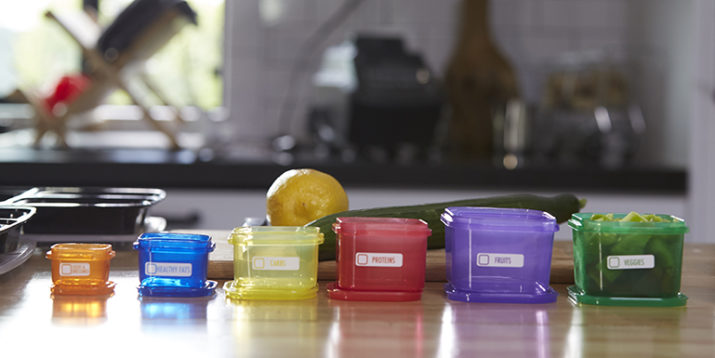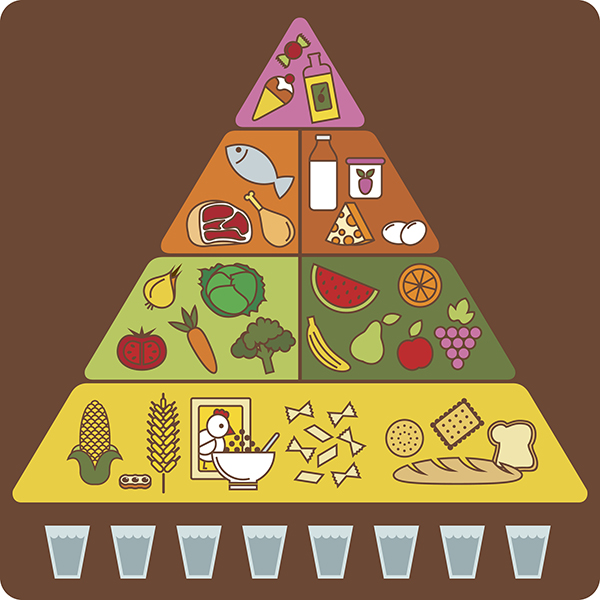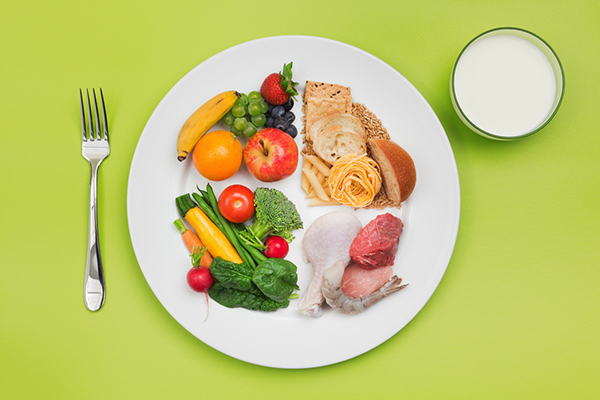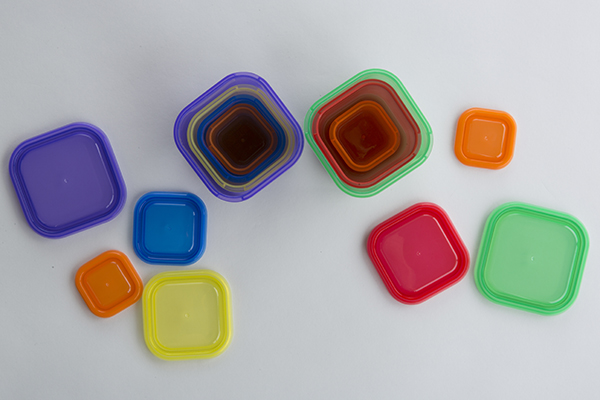How Many Servings from Each Food Group Do I Need?

Between the likes of Big Gulps, foot-long subs, and trenta-sized lattes (31 ounces!), we’re living in a super-sized world. The proof?
- Between 1977 and 1996, food portion sizes increased inside and outside the home for most types of junk food.
- The standard plate size has grown from 9.6 inches to 11.8 inches since 1900.
So, if portion sizes are completely out of whack these days, then how can you tell how much you’re really eating, and how much should you be eating every day, anyway?
To help make it easier for people to eat the right amount of servings from each food group, BODi created the Portion Fix Eating Plan, a container system designed to manage your portions, calorie intake, and macro distribution without doing any math or weighing ingredients. (Get the complete lowdown on the container system here.)
(Pro tip: Want ideas on how to eat right and get fit? Download our free “100 Ways to Lose Weight” guide here!)
“A lot of fad diets encouraging low-fat intake or low-carb intake have faded in and out of popularity, but the pendulum in research always tends to swing back to the center, stressing moderate carbs and an equal split of healthy fats and proteins,” says Paige Benté, M.S., R.D., C.S.S.D.

What Are the Food Groups?
Remember the food pyramid from elementary school? If you paid attention in health class, you’ll recall the Food Guide Pyramid divided food into five groups. At the bottom of the Pyramid were grains (6–11 servings), then fruits (2–4 servings) and vegetables (3–5 servings), then protein and dairy (2–3 servings of each), then at the top were fats/oils/sweets.
It was useful in letting people know what foods to focus on, but there were significant gaps in key information: “The food pyramid gives you an idea of what foods to eat, but it doesn’t tell you how many servings of each group you need for your weight,” says Benté. “It’s not specific to you and your body on an individual level.”
The Pyramid also didn’t distinguish between types of fat, simply recommending that fat be consumed “sparingly,” and there was no specific guidance on grains.

What Is MyPlate?
The USDA replaced the Food Pyramid with MyPlate, which is a bit more accurate, but overlooks an important detail: weight.
“MyPlate is great because it shows you how to create a plate with half of it full of fruits and vegetables, and the other half split between grains and proteins, but it still doesn’t take into account the body weight of the individual,” says Benté. “This is an important factor in determining proper portion control.”
If you’re having trouble hitting your daily target for vegetables, whether it’s because you just don’t like greens or you don’t have access to a wide variety, it’s good to have a Plan B. A greens supplement like Power Greens can help you fill in the gaps in your diet.
Even better? Add Power Greens to a daily Shakeology and you’ll be well on your way to meeting your target.

The Portion Fix Food Groups
Portion Fix is similar to the USDA’s food groupings, but it doesn’t have a specific category for dairy, opting for three additional groupings: healthy fats; seeds and dressings; and oils and nut butters. Here are the food groups in Portion Fix, with examples:
Veggies: kale, collard greens, spinach, string beans, artichokes, eggplant (green container)
Fruits: berries, watermelon, oranges, apples, apricots, grapefruit (purple container)
Proteins: sardines, boneless and skinless chicken or turkey breast, fish, eggs, tempeh, tofu, Shakeology (1 red container)
Carbs: sweet potato, yams, quinoa, beans, lentils, edamame, brown rice (yellow container)
Healthy fats: avocado, most nuts, hummus, cheese, coconut milk (blue container)
Seeds & dressings: pumpkin seeds, sunflower seeds, olives (orange container)
Oils & nut butters: extra-virgin olive oil, nut butters, seed butters (teaspoon)
Do Food Group Servings Differ for Men and Women?
Body mass is the biggest reason to account for dietary differences between men and women. “There’s definitely a difference between a 120-pound female looking to maintain her weight and a 250-pound male who’s trying to bulk up — and as such, they’ll need very different amounts of food,” says Benté.
For example, the first step of the Portion Fix program is to calculate your “Calorie Target” to determine the portion plan that works best for you and your body type — and weight plays a big role. Multiplying your weight by 11 will give users a caloric baseline, which you can then use to calculate your maintenance calories, or the number based upon your exercise regimen.
Now that you have your Calorie Target, you can determine the portion plan that best suits your body’s needs and goals. There are six plans in the Portion Fix program, and the range between Plans A and F are substantial for those reasons.
Do Food Group Servings Change When You’re Working Out?
Once you’ve calculated your caloric baseline, it’s time to honor all that hard work from your workouts.
“It’s really important to restore the calories you’ve lost after working out,” notes Benté. “If you’re doing really intense workouts, you’ll burn a bunch of calories, and you’ll need to make sure you’re getting enough protein and fat to maintain muscle mass, cellular function, and brain function. And you’ll need enough carbs for energy and to replace muscle glycogen.”
That’s especially true with those looking to seriously build muscle mass; research shows that optimal protein intake for bodybuilders during periods of intense training are significantly higher.
To ensure you’re meeting your body’s needs, here are some guidelines :
For a moderately challenging workout (e.g., jogging, yoga, 21 Day Fix, or Rockin’ Body): Add 400 to your caloric baseline.
For an extremely challenging workout (e.g., long-distance running, SHIFT SHOP, or 22 Minute Hard Corps): Add 700 to your caloric baseline.
From there, it’s all about the goal:
To lose weight: Subtract 750
To gain weight: Add 350
To maintain: Leave your number as is
What Do I Do If I Eat Too Much of One Food Group?
While it’s only natural to have some days where you don’t meet your daily intake needs, Benté says it’s important to do everything in your power to stick to your individualized food group plan.
“Each day is a fresh start, so it’s best to avoid undereating one day and overeating the next — a practice that only sets up a cycle of bad habits.”
